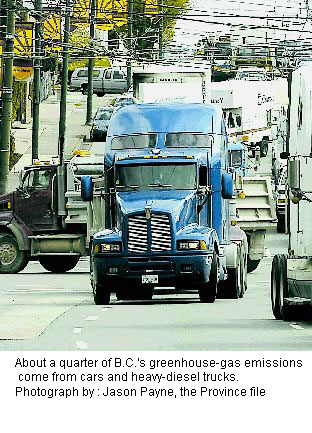B.C. tackles greenhouse gases
 (John Bermingham, The Province) - As talks begin with industry, experts say the key is putting a price on pollution
(John Bermingham, The Province) - As talks begin with industry, experts say the key is putting a price on pollutionWhat would you pay to emit a tonne of greenhouse gas?
The answers from industry varied as Premier Gordon Campbell kicked off a series of climate-change meetings with industry leaders Friday.
Experts predicted that setting a dollar figure for carbon-dioxide emissions – a price per tonne to be paid by polluters – would be the key to Campbell’s goal of cutting B.C.’s greenhouse-gas emissions by 33 per cent by 2020. Industry spokesmen appeared to agree.
The first meeting, held in Kamloops with the B.C. agriculture industry, was an “excellent start,” according to provincial Agriculture Minister Pat Bell.
Agriculture accounts for four per cent of B.C.’s emissions. Bell said the goal is to reduce that by 30 per cent by 2020.
The agriculture industry says it wants to benefit from reducing its emissions. Ideas presented Friday included a suggestion by the landscape-nursery industry to market nursery trees that absorb more carbon dioxide.
Bob Friesen, President of the Canadian Farming Association, said farmers need a way to make money for reducing their emissions, too.
“We are ready and raring to go, as far as trading carbon credits, but federally, nothing has ever been put in place for farmers to be able to trade those credits,” Friesen said.
U.S. farmers are already trading carbon credits on their own exchange, he noted.
Ian Bruce, climate-change specialist with the David Suzuki Foundation, said it’s time to put a dollar figure on greenhouse emissions.
“It’s currently free to pollute the atmosphere. So we need to level the playing field between fossil-fuel energy and clean, green energy,” Bruce said.
The B.C. Green Party has called for a price of $50 per tonne of carbon dioxide, rising to $100 by 2020.
About 25 per cent of B.C.’s emissions come from cars and heavy-diesel trucks, 20 per cent from the oil and gas industry.
Matt Horne, policy analyst with The Pembina Institute, said charging for emissions would be a price-signal to the economy that business can work with.
“The No. 1 thing that has got to be there is a price on carbon,” he said. “Once you’ve got those signals in place, people will start responding to them.”
Horne said pricing CO2 is the basis of all emissions-reduction mechanisms, including carbon taxes, carbon offsets and cap-and-trade systems.
Horne said the best way to cut emissions by a third is through regulations, a dollar figure for carbon and public programs and education.
John Winter, President of the B.C. Chamber of Commerce, said big business is willing to reduce its emissions, as long as it doesn’t damage economic output.
“We’re looking for reality and fairness,” said Winter. “We want to make sure we proceed on this thing in a responsible way, and not destroy the good that’s been done up to now.”
NDP environment critic Shane Simpson said he’s concerned the discussion with industry will be about trading carbon-offsets, not reducing greenhouse-gas emissions.
“[It’s] ‘how do I buy my way out of the rest of my problem of emissions?’” said Simpson. “And that doesn’t solve our problem.”
You can return to the main Market News page, or press the Back button on your browser.

